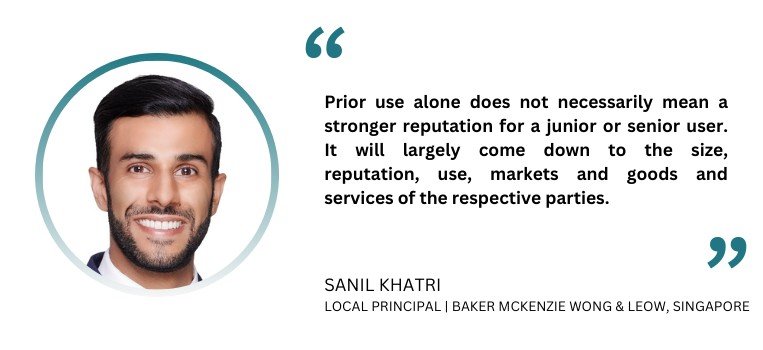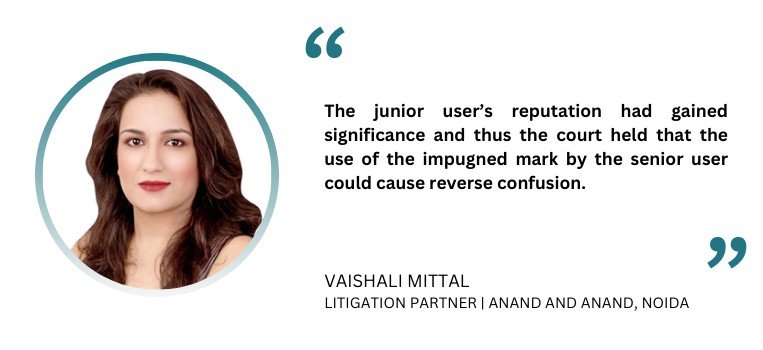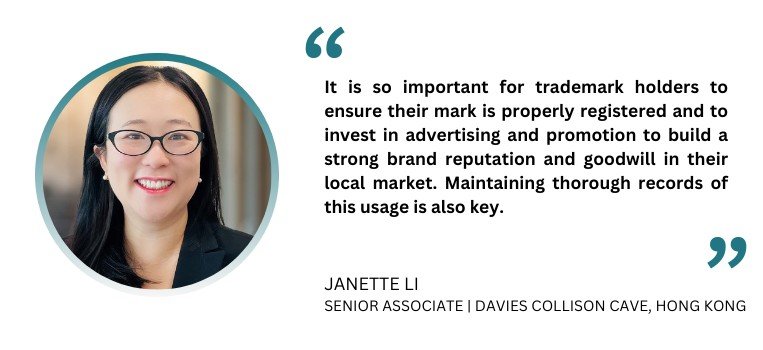The reverse confusion theory in trademarks
31 October 2024

Is there a conflict between reverse confusion and prior use? Espie Angelica A. de Leon defines reverse confusion and explores the legal challenges and strategies to protect IP and maintain brand integrity.
When Facebook announced its intention to rebrand and change its name to Meta in 2021, certain companies with business names that included “Meta” were up in arms. One of them was MetaX, also known simply as Meta.. Established in 2010, MetaX is engaged in the virtual reality business identical to Facebook’s services. The company registered the Meta trademark in 2017.
Following Facebook’s rebranding, MetaX owner Justin Bolognino in 2022 filed a suit against its parent company Meta Platforms for trademark infringement and unfair competition before the Southern District Court of New York.
According to news reports, Bolognino said Facebook’s rebranding decimated his business. “Now my client goes out to try to market and promote its services, consumers now falsely and mistakenly believe that its services are coming from Facebook,” Bolognino’s attorney Dyan Finguerra-DuCharme, a New York-based partner at Pryor Cashman, told CNBC.
This is a case of reverse confusion.

“Reverse confusion in competitors’ use of trademarks occurs when a larger, more powerful entity adopts a mark that is identical or similar to a smaller, prior user’s trademark and overwhelms the prior user’s market, causing the public to mistakenly believe that the prior user’s goods or services originate from or are associated with those of the larger, junior user,” explained Binny Kalra, a partner at Ira Law in New Delhi. Under these circumstances, the goodwill and market identity established by the senior or prior user is undermined.
Reverse confusion is opposed to forward confusion, which arises when a small business entity uses a business name or logo similar to that of a bigger entity, causing confusion among consumers. They will be led to believe that the smaller company’s or junior user’s products or services originate from or are associated with those of the bigger company or senior user. Forward confusion is also called direct confusion.
Reverse confusion and prior use: Is there a clash?

Sanil Khatri, local principal at Baker McKenzie Wong & Leow in Singapore, said the theory clashes with the concept of prior use in that reverse confusion typically attributes a greater reputation to the junior user, whereas prior use alone does not necessarily mean a stronger reputation for a junior or senior user. “It will largely come down to the size, reputation, use, markets and goods and services of the respective parties,” he said.
Explaining further, Kalra said: “Conventional trademark law is premised on the protection of the rights of the senior or prior user against confusion caused by a subsequent user. In reverse confusion, the senior user’s rights are undermined, not necessarily because the larger entity is trying to capitalize on the senior user’s reputation and goodwill but because the junior user’s commercial strength and reputation are such that it significantly overshadows the reputation of a lesser known and commercially weaker senior user.”
According to Pravin Anand, managing partner at Anand and Anand in Noida, even if prior use is paramount and triumphs even over a registered trademark as stated under Section 27(2) of India’s Trademarks Act, 1999, sporadic and intermittent use of the mark will not bestow trademark rights.

“In order to establish prior use, it is important that the mark has been continuously in use in a commercial setup. In the context of the confusion theory, the junior user will have to prove sporadic and intermittent use whereby the senior user has not generated enough goodwill in order to overcome the problem of prior use,” said Anand.
Owen Gee, managing principal at Davies Collison Cave in Hong Kong, added that If a junior user has prior use before a senior user gets to register the mark, this prior use can be used as a defence to a senior user’s infringement action. This works whether forward confusion or reverse confusion is relied upon.
However, challenges arise for the senior user if reverse confusion is relied upon.

Gee explained: “In cases where reverse confusion is asserted, use and reputation of the senior user’s mark is often limited, including prior to registration. This makes the use of reverse confusion more challenging for a senior user in overcoming a prior use defence. It is even more challenging if the distinctiveness of the senior user’s mark is low, given that such a mark can be an exception to infringement in any event.” To offer an example, Gee cited a descriptive mark or a mark with descriptive elements. He said similar challenges also apply, and can be even more relevant, to a senior user’s unregistered marks.
For Rebeccah Gan, principal at Muncy, Geissler, Olds & Lowe in Alexandria, Virginia, reverse confusion and prior use don’t clash at all.

“Reverse confusion is simply that a ‘junior user,’ typically a junior user of financial means overwhelms a senior user. In a successful reverse confusion case, the prior or senior user demonstrates injury and is compensated accordingly,” she said, adding that if junior users bargain in good faith to resolve conflicts, litigation can be avoided.
The doctrine of reverse confusion in India, Singapore, Hong Kong and the U.S.
Vaishali Mittal, litigation partner and strategist at Anand and Anand in Noida, cited two cases in India where reverse confusion was applied.
One of these is Allianz Aktiengesellschaft Holding v. Allianz Capital and Management Services.

“In this case, the junior user’s reputation had gained significance and, thus, the court held that the use of the impugned mark by the senior user could cause reverse confusion. The High Court finally limited the fields of operation of both the senior and the junior user while deciding the matter,” said Mittal.
Another is Intex Technologies (India) v. AZ Tech (India), which was handled by Anand and Anand. “In this case, the Honourable Division Bench of the Delhi High Court, disagreeing with the grant of an interim injunction by the Single Judge in favour of a senior user, held that in order to establish reverse confusion, there must be tangible evidence to show that the junior user was able to swamp the goodwill and reputation of the senior user,” Mittal said.
Generally, though, reverse confusion has been sparingly applied or discussed in India.
Khatri’s firm has handled trademark cases of reverse confusion. “We identified the users of the respective marks at an early stage, the relevant goods and services, the relevant markets and consumers and reached out on behalf of the senior user to the junior user to negotiate at an early stage,” he related. “We have been fortunate enough to obtain favourable outcomes for our clients given the timely and commercial approach taken during negotiations.”
On a general level, however, the use of reverse confusion theory is likewise not commonly seen in Singapore. “There is no established test for determining reverse confusion in Singapore. However, courts in other jurisdictions have ordinarily adopted a multi-factorial approach, similar to that for forward confusion cases, which includes a consideration of factors,” said Khatri. It remains to be seen whether the increasing popularity of the reverse confusion theory in other jurisdictions will extend to Singapore.
Asked if Hong Kong courts have seen many cases involving reverse confusion, Gee mentioned the prolific rise of social media and social networking platforms and how brands are harnessing these technologies to promote their products. “Social media and social networking platforms have made it easier for junior users to quickly saturate a market and displace marks of senior users, especially powerful junior users with substantial resources,” he noted. “It would not be surprising to see a rise in popularity in the use of doctrines such as reverse confusion by senior users to stem an oncoming tide of use of a conflicting mark by a junior user.”
As far as the United States is concerned, Gan said reverse confusion is quite popular in the country because of its market realities. The Facebook–MetaX incident is a case in point. Actually, Facebook has settled several cases for Meta marks of senior users before the former changed its parent company’s name. “I think because we have so many large companies in the U.S., in certain industries such as fashion, toys and others, [that] there is an economy of scale advantage where big companies can overwhelm smaller manufacturers. Therefore, the consumer believes that the large entity is the source of the goods because they can quickly get a similar, cheaper to produce, product to market and advertise it widely, etc.,” Gan explained.
Determining reverse confusion
How is reverse confusion determined? Our interviewees named the following factors that help determine the existence of reverse confusion:
-
Similarity of the competing marks.
-
Strength of the prior user’s trademark.
-
Commercial strength and extent of reach of the junior user under its trademark.
-
Intent and conduct of the junior user in adopting a similar mark. “The plaintiff must show that the defendant knew of and intentionally disregarded the plaintiff’s rights in order to make out a reverse confusion claim,” said Gan.
-
Extent of overlap between the goods or services of the senior user and junior user.
-
Difference in quality of the product and/or service.
-
The likelihood of expansion of the product and/or service.
-
Harm or prospective harm likely to be caused to the senior user’s goodwill and business reputation due to the expansion and growth of the junior user.
-
Overlap and nature of the senior and junior users’ consumer bases.
-
Added matter, if it is sufficient to dispel consumer confusion.
-
Evidence of actual confusion. Such evidence may include sales and advertisement expenses, market surveys and the like with respect to the presence of the senior user prior to the junior user’s use of the trademark.
These factors are similar to those considered to determine forward confusion. The difference lies in how such factors are considered. “For example, the commercial strength of the junior user will likely be an important factor in order to demonstrate that the junior user has swamped the market and overwhelmed the senior user’s mark. With evidence of actual confusion, evidence showing that consumers believe the senior user’s products are associated with the junior user, or worse, the senior user is infringing the junior user’s mark, will likely support reverse confusion,” explained Gee.
Guarding against reverse confusion: some tips
What can trademark holders with prior rights or prior use do to prevent the occurrence of reverse confusion and protect their brands’ goodwill and market identity? Our interviewees offered the following tips:
Be proactive on all fronts – registration, promotion and monitoring. According to Janette Li, a senior associate at Davies Collison Cave in Hong Kong, being proactive is crucial because junior users are often the larger companies that are expanding into new markets without prior knowledge of an existing senior user.

“That’s why it is so important for trademark holders to ensure their mark is properly registered and to invest in advertising and promotion to build a strong brand reputation and goodwill in their local market. Maintaining thorough records of this usage is also key,” said Li.
“But the real linchpin is proactive market monitoring,” she added. “Trademark holders must be vigilant in identifying any third parties using the same or similar marks, and then seek professional advice immediately on the best enforcement approach.”
Li cited the case of the Tsit Wing Group, which has been operating in Hong Kong since 1932, and The Wellness Group, which was established in Singapore in 2008.
Tsit Wing is a wholesaler of coffee and tea products, a distributor of branded tea and coffee machines and a supplier of instant beverage products. It has been using TWG trademarks for several decades.
The Wellness Group is engaged in the development of a luxury tea brand and was also using TWG as a trademark. From its beginnings in 2008, the company grew quickly and expanded. In 2011, it opened a tea salon at the IFC Mall in Hong Kong. Tsit Wing quickly took action. “They succeeded in their trademark infringement and passing off claims, demonstrating the importance of swift enforcement,” said Li.
For Kalra, proactive monitoring is invaluable, especially if the trademark holder does not have the capacity to litigate. “Proactive monitoring allows for timely corrective measures to address potential issues in the early stages of adoption of a junior user’s similar trademark or interrupt its rapid expansion. Depending on facts, negotiating fair terms for co-existence while avoiding potential conflicts becomes a realistic possibility as a method of resolution,” she said.
Khatri added that trademark holders should continuously monitor marks published for opposition purposes by IP offices. For this task, there are numerous trademark watch services available in the market. “Such watch services are important as they can alert businesses to trademark applications that a holder of an earlier trademark may consider to be confusingly similar to their own mark, that are not rejected by the local IP office. By challenging and opposing such applications at the outset before they are registered, businesses can reduce the risk of any confusion, including reverse confusion, from arising at a later stage,” he stated.
Since reverse confusion can also arise from an unregistered trademark, Khatri suggested that companies conduct searches for their marks that are already being used or registered. This will ensure there are no later marks being used in the market that will potentially overshadow the prior mark.
“Reaching out to the junior users that are bigger establishments to notify them of concerns of consumer confusion at an early stage is preferable,” Khatri advised, “before the junior user becomes more tied to a certain brand, investing greater resources and less willing to cease use.”
Continue commercial use of the marks. “This can be done by investing in advertisement and promotional activities. This will help create strong brand recognition,” said Anand.
Make sure your website and social media accounts are informative and regularly updated. Doing this will help promote consistent and broad customer reach. “Visitor comments are often invaluable in pointing to marks that appear similar to consumers,” Kalra explained.
The reverse confusion theory may not be common in some jurisdictions such as India, Singapore and Hong Kong. But as Gee said, this is the era of the internet and social media. These modern technologies provide an additional avenue for product and service promotion. As such, the internet has made it easier for a junior user to allow its newer mark to gain a foothold in the market until its trademark overshadows that of a senior user. Consider the fact that junior users, in reverse confusion incidents, are established enterprises, and global industry frontrunners such as Facebook, with plenty of resources at their disposal. Will this cause a rise in the use of the reverse confusion doctrine in these jurisdictions?






